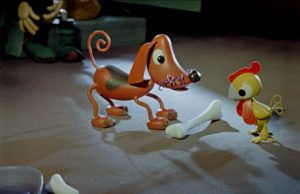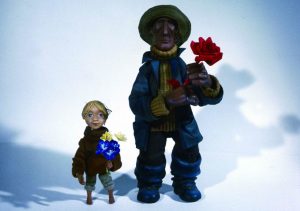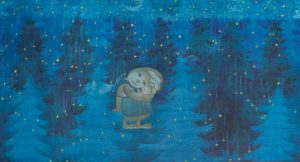Latvian animation today is characterised by a very diverse use of techniques, imaginative expression and the pronounced dominance of auteur cinema. Latvian animation filmmakers have been awarded all over the world, from Annecy to Oscars, and they are written about in international monographs and media publications. This broad and high-quality animated film scene links to an older tradition in which technical precision and superior content have been a priority.
The origins of Latvian animation date back to the 1930s,
when graphic artist Oļģerts Ābelīte and caricaturist Ernests Rirdāns experimented with the technique. As filming technologies became more available, an amateur filmmaking movement emerged in the 1950s, and some of these filmmakers focused on animated films. At the same time, however, an enduring tradition of animation took root at the Riga Film Studio, the epicentre of professional cinema in Latvia.
The first years of professional animation in Latvia were characterised by puppet theatre, refined camerawork and studies of the work of the Soviet Union’s central animation studios. The first work of professional Latvian animation was Ki-ke-ri-gū! / Cock-a-doodle-doo!, a puppet film by Arnolds Burovs released in 1966. At the time, Burovs was already an experienced and award-winning puppet theatre director; he had approached the film studio with his closest colleagues and had soon formed a close-knit group of animators. The puppet makers and puppeteers were joined by cinematographer Pēteris Trups, who used subtle camerawork and lighting to achieve psychologically powerful shots of the puppets’ motionless faces.

The Burovs group collaborated with various artists and based many of its films on fairytale / fantasy or historical environments as well as exquisite recreations of 1920s Riga. The rhythm and composition of its films are characterised in large part by slowness, contemplation and nostalgia, which echo their themes and environments; the humorous films, for their part, carefully capture the details of Soviet life.
Roze Stiebra entered the animation scene at almost the same time. She had studied puppet theatre directing and joined the Telefilma-Rīga creative group at Latvian Television with the intention of filming productions of puppet theatre. Soon, however, she decided to focus on “real” animation. This idea initially surprised her superiors and fellow colleagues, but cinematographer Ansis Bērziņš, already recognised for his work in documentary cinema, responded favourably. He helped Stiebra find the necessary equipment and shared his knowledge of working with cameras.
Stiebra and Bērziņš made their first films using the cutout technique and a variety of materials, which they selected together with an artist.
For their first film, Lietaina diena / Rainy Day (1969), the characters were made of fabric-covered cardboard. Later, they used pastels, oil paints, watercolours and other materials. However, starting with Kabata / In My Pocket in 1983 they focused on classic hand-drawn animation. Stiebra and Bērziņš have made many innovative films together, but musical films came to the fore already quite early in their collaboration. Stiebra’s films often contain symbolically rich, concentrated images and characters based on Latvian literature or folklore. In their collaborations with artists and writers, Stiebra and Bērziņš sought a vivid style and encouraged artists to abandon their notions of what animated characters ought to look like.
Like Burovs, Stiebra and Bērziņš mostly created films that could be considered children’s cinema. This made it easier to work within the harsh restrictions imposed by the official stance of Socialist Realism and gave them the freedom use their imaginations to the fullest. However, their films nevertheless contain strong yet nuanced, multi-layered messages and adhere to high artistic standards. With artistic obstinacy, they seem to resist the assumption that children’s art is simple or insignificant – for example, a film may feature multi-level panoramas made using cutouts, or a complex construction of the sea in a puppet film.

For technical and financial reasons, in the late 1980s the hand-drawn animation team moved into a space located next to the puppet team, in the same second-floor hallway, and began working on its first feature-length film, Ness un Nesija / Ness and Nessy (1991). Meanwhile, a new generation of puppet directors had joined the puppet group at the Riga Film Studio. In addition to Burovs, Arvīds Noriņš (debut in 1970), Gunārs Treibergs (debut in 1982) and Jānis Cimmermanis (debut in 1984) now began making films as well. Cimmermanis eventually became the main director at the studio in the 1990s. This is also when, in close collaboration with artist and screenwriter Māris Putniņš, the Avārijas brigāde / Rescue Team series of humorous short films was begun, which continues to be made today. Overturning the tradition of psychological puppet animation established by Burovs, Putniņš and Cimmermanis used the animation genre to elegantly poke fun at developments in society, including the collapse of the Soviet regime and the vague challenges of an independent parliament.
The changes Latvia experienced as it regained independence brought diversity to Latvian animation, and the cinematic landscape, once so easily overseeable, became more individualistic.
With the collapse of the Soviet film studio system, the puppet and hand-drawn animation groups established a joint studio called Dauka; soon, however, the puppet group split away and set up its own studio, Animācijas Brigāde. New directors began working at the hand-drawn film studio, among them Signe Baumane and Edmunds Jansons, both now internationally recognised and award-winning directors of auteur cinema. At the puppet studio, cinematographer Nils Skapāns made his directorial debut with the Munk and Lemmy series, and soon the Lidojam ?! / Let’s Fly?! episode (1996) was awarded the Crystal Bear for best children’s short film at the Berlin International Film Festival. Over time, Dace Rīdūze and Māris Brinkmanis joined the team, while Skapāns began developing plasticine animation techniques.
Producer Vilnis Kalnaellis left the Dauka studio and established the Rija studio in 1995, which placed more emphasis on integrating with the global animation industry and the production and distribution of films. A clear division between animation studios emerged: Rija would be very open to international collaboration and festivals, while Dauka would remain oriented towards Latvian audiences and support the involvement of Latvian artists and authors in its films.

Soon the three big studios were joined by a number of smaller animation studios as noteworthy animation directors founded their own companies. Vladimirs Ļeščovs founded the Lunohod studio, thus maintaining his distinct style and concentrating on auteur filmmaking, which does not submit well to the pace of work at studios involved in large projects. Edmunds Jansons chose a different approach in establishing the Atom Art studio, which does co-productions of a larger scope and aimed at larger audiences as well as short films by various filmmakers for narrower audiences of festival-goers and animation aficionados.
Today’s filmmakers are entering animation with ever more diverse experience and are encountering there an increasingly diverse approach to the medium, allowing us to speak confidently about animation in Latvia as an unlimited form of art in terms of style and genre.
Latvia’s animation power is rooted in a strong and growing tradition of auteur short films, but since the beginning of the 21st century the number of feature-length animated films has been steadily increasing, and Latvia can begin to be called the animation superpower. With seven feature-length animated films released in the second decade of the century (2011-2019) and eight more to be completed in the next five years (2020-2025), this pace and scale clearly sets Latvia apart from other European countries. Naturally, the development of the industry has been followed by success – the Latvian animation phenomenon has become a global one. Thanks to the incredibly successful and powerful feature-length animated film Straume / Flow (2024) by director Gints Zilbalodis and producer Matīss Kaža. Standing ovations at its world premiere at the Cannes Film Festival, four awards at the Annecy Film Festival, the European Film Academy Award, the Golden Globe and, last but not least, the Oscar / Academy Award for Best Animated Film along with almost a hundred different awards at festivals around the world and millions of viewers in cinemas in 45 countries – all this has been and is being engraved in the history of Latvian cinema of 2024 and 2025. And the overall picture and background of Latvian animation shows that we can expand our reach because the tradition is strong and there are many young talents working hard towards their success stories.
Ieva Viese, Animation Expert